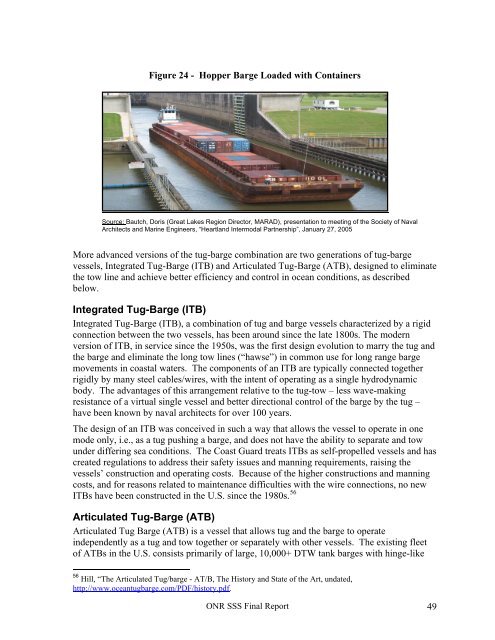Office of Naval Research - National Transportation Library
Office of Naval Research - National Transportation Library
Office of Naval Research - National Transportation Library
Create successful ePaper yourself
Turn your PDF publications into a flip-book with our unique Google optimized e-Paper software.
Figure 24 - Hopper Barge Loaded with ContainersSource: Bautch, Doris (Great Lakes Region Director, MARAD), presentation to meeting <strong>of</strong> the Society <strong>of</strong> <strong>Naval</strong>Architects and Marine Engineers, “Heartland Intermodal Partnership”, January 27, 2005More advanced versions <strong>of</strong> the tug-barge combination are two generations <strong>of</strong> tug-bargevessels, Integrated Tug-Barge (ITB) and Articulated Tug-Barge (ATB), designed to eliminatethe tow line and achieve better efficiency and control in ocean conditions, as describedbelow.Integrated Tug-Barge (ITB)Integrated Tug-Barge (ITB), a combination <strong>of</strong> tug and barge vessels characterized by a rigidconnection between the two vessels, has been around since the late 1800s. The modernversion <strong>of</strong> ITB, in service since the 1950s, was the first design evolution to marry the tug andthe barge and eliminate the long tow lines (“hawse”) in common use for long range bargemovements in coastal waters. The components <strong>of</strong> an ITB are typically connected togetherrigidly by many steel cables/wires, with the intent <strong>of</strong> operating as a single hydrodynamicbody. The advantages <strong>of</strong> this arrangement relative to the tug-tow – less wave-makingresistance <strong>of</strong> a virtual single vessel and better directional control <strong>of</strong> the barge by the tug –have been known by naval architects for over 100 years.The design <strong>of</strong> an ITB was conceived in such a way that allows the vessel to operate in onemode only, i.e., as a tug pushing a barge, and does not have the ability to separate and towunder differing sea conditions. The Coast Guard treats ITBs as self-propelled vessels and hascreated regulations to address their safety issues and manning requirements, raising thevessels’ construction and operating costs. Because <strong>of</strong> the higher constructions and manningcosts, and for reasons related to maintenance difficulties with the wire connections, no newITBs have been constructed in the U.S. since the 1980s. 56Articulated Tug-Barge (ATB)Articulated Tug Barge (ATB) is a vessel that allows tug and the barge to operateindependently as a tug and tow together or separately with other vessels. The existing fleet<strong>of</strong> ATBs in the U.S. consists primarily <strong>of</strong> large, 10,000+ DTW tank barges with hinge-like56 Hill, “The Articulated Tug/barge - AT/B, The History and State <strong>of</strong> the Art, undated,http://www.oceantugbarge.com/PDF/history.pdf.ONR SSS Final Report 49
















